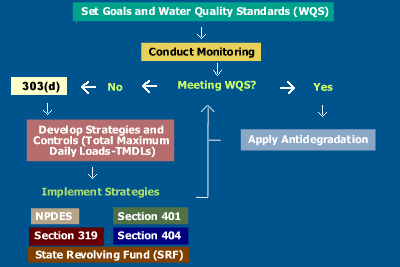
Watershed Academy Web
Introduction to the Clean Water Act

Although most commonly associated with activities that involve filling of wetlands, Section 404 actually deals with one broad type of pollution -- placement of dredged or fill material into "waters of the United States". Wetlands are one component of "waters of the United States;" however, there are numerous other types -- intermittent streams, small perennial streams, rivers, lakes, bays, estuaries, and portions of the oceans.
One of the controversial aspects of Section 404 is exactly what is and isn't a wetland. Federal regulations define wetlands as:
"Those areas that are inundated or saturated by surface or ground water at a frequency and duration sufficient to support, and that under normal circumstances do support, a prevalence of vegetation typically adapted for life in saturated soil." [33CFR328.3(b)] (bold added)
For an area to be declared a wetland, it should exhibit all three of the key features -- hydrology, wetland-dependent vegetation, and soil types associated with water-saturated conditions. However, some kinds of wetlands, such as bottomland hardwood swamps, are dry during some periods. The absence of water or saturated soil at any given moment does not render a plot "not a wetland," if the vegetation and soils indicate that wet conditions often do occur and hydrological data support this conclusion.